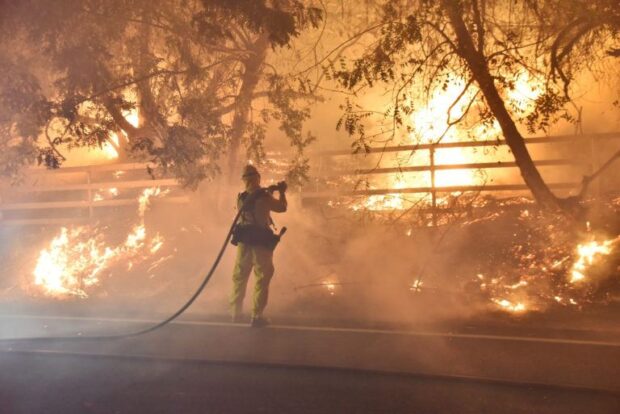Despite a relatively average 2022 wildfire season, fears of wildfires remain at an “all-time high,” and those fears appear to be one driver of decision-making on property insurance.
A new report from Gallagher Re shows the threat of damaging wildfires in conjunction with inflation and pricing challenges has led to a distressed insurance and reinsurance market, particularly in California.
Gallagher Re’s 2023 U.S. Wildfire State of the Market report gives a rundown of last year’s wildfire season, as well as some commentary on causes, effects and market conditions.
The report’s release follows a developing problem in the fire-prone Western U.S, particularly in California, where carriers are pulling back from writing wildfire insurance in the state.
Eight of the state’s top 20 wildfires have occurred in the last half-dozen years, burning 8,512 structures, according to the Western Fire Chiefs Association. Those losses do not reflect the destruction from the Camp Fire in 2018, the state’s most destructive and deadliest fire, which destroyed 18,804 structures and cost over $16.5 billion.
The Gallagher Re report also addresses growing wildfire threats in other states, such as New Mexico’s devastating wildfire season, and a large and severe fire season in Alaska. The recent years of devastating losses have shifted the view of wildfire risk and led to changes in how it is managed and priced by insurers, according to the report.
“The recent market dislocation signals a new focus on managing wildfire risk,” the report states.
That new focus has been noticeable in California.
State Farm General Insurance Co. announced at the end of May that it had stopped accepting new policy applications for property/casualty insurance in California for reasons including increased risks from wildfires and inflation. The decision followed a similar move by Allstate Corp. last year.
Other large carriers that have announced a reduced appetite for writing California homeowners insurance include American International Group (AIG) and Chubb.
State Farm’s decision to no longer write new personal or business property/casualty policies in California got the attention of Fitch Ratings, which said the move “reflects the poor underwriting experience for California homeowners’ writers.”
Fitch said the decision will further restrict coverage availability in California and prompt premium rate increases going forward.
The Gallagher Re report also calls out climate change and continued development in the wildland urban interface for the increased threat of damaging wildfires.
“The continued influence of climate change amplifies the conditions that affect wildfire behavior and extends the season when large and damaging fires can occur, resulting in rising physical costs related to wildfires in the U.S. Long-term temperature and precipitation patterns across the Western U.S. have trended toward warmer and drier conditions, particularly during the peak fire season months of May to November,” the report states.
The risk is compounded by land management practices and expanding urban footprints, particularly within areas in or near densely vegetated areas, known as the wildland urban interface, according to the report.
“The developments in the WUI have increased dramatically in recent years,” the report states. “In California alone, there was a 39 percent increase in housing units in the WUI from 1990 to 2020, according to data from UW Madison SILVIS Lab. Throughout the neighboring U.S. states, housing units in the WUI during the same period increased by 46 percent.”
Nearly 44 million housing units were situated in the WUI by 2020. California had 5.1 million units in the WUI, the report notes.
The report also keys in on reinsurance, which it says has gone through “a dramatic change” in the last six years since following historic levels of loss from wildfires and other natural catastrophes that led to a large increase in reinsurance rates, higher retentions and contractual tightening.
According to the report, property reinsurance rates have risen by more than 60 percent from 2017 to the Jan. 1, 2023, renewals.
“It’s unfortunately a perfect storm for insurance carriers, where you have climate change happening, you have changes in demographics and how people are living and building into a wildland urban interface, and as a result, large wildfires in recent years,” said Toby Hardman, executive vice president at Gallagher Re and one of the report’s authors. “And what’s happening there is it’s causing insurance carriers to have significantly increased financing costs, where before it was really cost-effective to finance wildfire loss through reinsurance or wildfire exposure through reinsurance, those prices have dramatically changed in just a handful of years. And then put on top of that increase a really high inflationary environment, and it results in a very dynamic and evolving marketplace in California especially.”
Outside of California, Gallagher Re is seeing a rapid growth in wildfire risks in states that a few years ago would have generated little worry for the insurance industry, Hardman said.
“California is always going to be by far the No. 1 area when it comes to managing wildfire, but we are seeing and helping our clients and carriers manage proactively wildfire outside of California, which was pretty close to non-existent just a few years ago in terms of really meaningful actions that were being taken by reinsurers and insurers.”





















 Executives on the Move at Liberty Mutual, Cowbell, W. R. Berkley
Executives on the Move at Liberty Mutual, Cowbell, W. R. Berkley  Why the Middle Market Matters and How Insurers Can Capture It
Why the Middle Market Matters and How Insurers Can Capture It  Underwriter, Actuary Fears of AI Drop; Work Needed on Collaboration
Underwriter, Actuary Fears of AI Drop; Work Needed on Collaboration  Artificial Intelligence Is Rewriting the Rules for Commercial Lines
Artificial Intelligence Is Rewriting the Rules for Commercial Lines 







